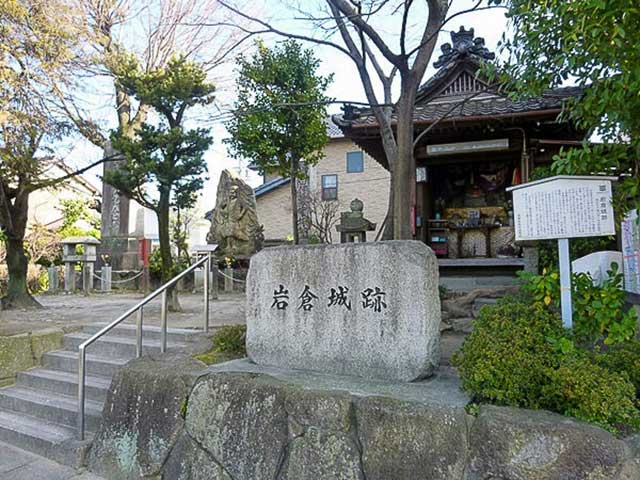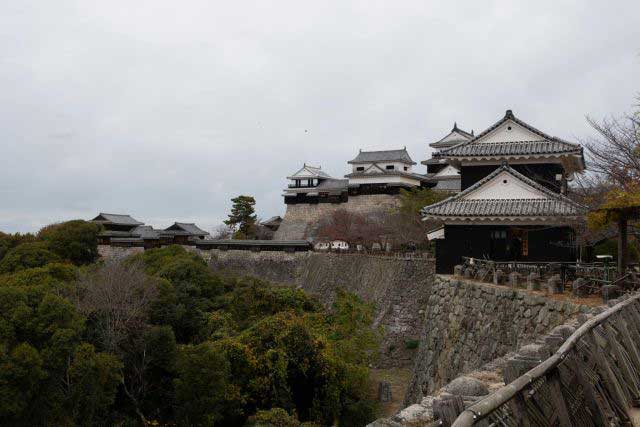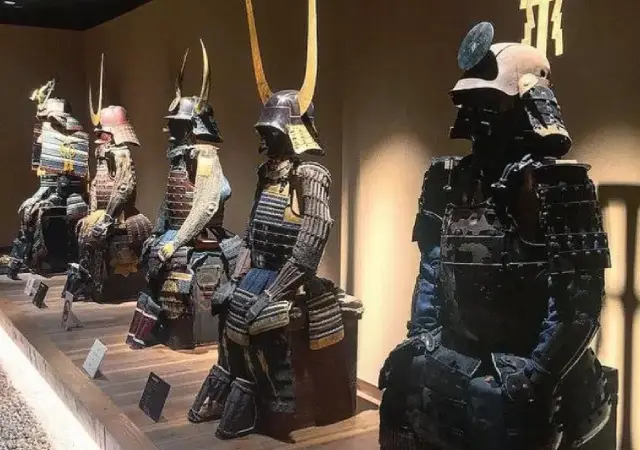
Iwakura Castle was a hira-jiro, or flat-land castle, located in the plains that would become Iwakura City, Aichi Prefecture. At one time, it rivaled Kiyosu Castle in size and stature. Constructed in 1479, it covered an area of 900 meters north to south and 400 meters east to west. Two sets of moats encircled the castle: the outer moat, about 10 meters wide, and the inner moat, about 15 meters wide, separated by a 10-meter-wide strip. These moats surrounded the Honjo, or main castle precinct, which measured about 170 meters north to south and 90 meters east to west. To the north and directly east of the castle flowed the Gojo River.
The castle's Ote-mon, or main gates, faced southeast, with the rear gates to the north. Directly south and to the northeast were large areas, roughly the size of the central precinct, designated for samurai housing.
During the Sengoku period, Owari Province was ruled by two main factions of the Oda clan. The Iwakura Oda clan held the northern districts of Owari, while the Kiyosu Oda clan ruled the southern areas. The famed Oda Nobunaga belonged to the Shobata Oda clan, a branch of the Kiyosu Oda family.
Nobunaga increased his power by defeating and overtaking the Kiyosu Oda. In opposition, the Iwakura Oda formed an alliance with Nobunaga's brother, Nobuyuki. However, they were defeated by Nobunaga at the Battle of Ukino in 1558, after which Iwakura Castle was attacked.
In June 1558, Oda Nobunaga surrounded Iwakura Castle with palisades, set the castle town ablaze, and placed it under a siege that lasted for two to three months. During the ensuing battle, Yamauchi Moritoyo, a vassal of the Iwakura Oda, was killed. His son, Katsutoyo, was temporarily unemployed until joining Nobunaga’s forces around 1567, later becoming the master of Kakegawa and Kochi Castles.
Nobunaga continuously launched fire-arrows and fired rifles into the castle, employing various tactics to wear down the defenders. Eventually, the besieged Iwakura forces found it too difficult to hold the castle and decided to surrender. The defenders left and dispersed, and shortly thereafter, Nobunaga had the castle destroyed, returning to his castle at Kiyosu, having achieved the unification of Owari Province.
Unfortunately, nothing remains of Iwakura Castle except for a monument standing on the site of the rear gates to the main enclosure.
See also
-
Iyo Matsuyama Castle

Historically, the center of Iyo Province—corresponding to today’s Ehime Prefecture on the island of Shikoku—was the city of Imabari, while the Matsuyama area was regarded as an agricultural hinterland with broad plains and low hills. During the Muromachi period, the central part of the province was governed by the Kano clan from Yuzuki Castle. With the onset of the Sengoku period, however, this clan lost its former influence and was forced to survive in the shadow of the more powerful Mori and Chōsokabe clans. After Toyotomi Hideyoshi’s forces conquered Shikoku in 1587, the northern part of Iyo Province was granted to Fukushima Masanori, one of the so-called “Seven Spears of Shizugatake.” In 1595, Masanori was transferred to Kiyosu Castle, and the lands around Matsuyama were given to another of the Seven Spears, Katō Yoshiaki, who received Masaki Castle and an income of 60,000 koku of rice.
-
Kanazawa Castle

Construction of Kanazawa Castle began in 1580 on the orders of Sakuma Morimasa, a vassal of Oda Nobunaga. The castle was built on the site of the Ikko-ikki sect's Oyama Gobo temple, which is why it is sometimes called Oyama Castle. Morimasa managed to build several moats and begin construction of a castle town. However, after his defeat at the Battle of Shizugatake in 1583, he was executed, and ownership of the castle passed to Maeda Toshiie (1538–1599).
-
Nakatsu Castle

Kuroda Yoshitaka (1546–1604) was one of the closest advisors to the legendary military commander Toyotomi Hideyoshi. He took part in key military campaigns of the late 16th century, including the campaign against Shikoku in 1585 and the campaign against Kyushu in 1587. Later, during the second campaign in Korea, Yoshitaka served as chief advisor to the commander of the invasion forces, Kobayakawa Hideaki. After Hideyoshi's death, he swore allegiance to Tokugawa Ieyasu, thereby securing his influence and patronage under Japan's new leader.
-
Edo Castle

The history of Edo Castle dates back to the Heian period, when the Edo clan built a small fort on this site. In 1457, the vassal of the Uesugi clan, Ota Dokan (1432–1486), constructed a full-scale castle here. Internal conflicts weakened the Uesugi clan, and in 1524, Ota Dokan’s grandson, Ota Yasutaka, surrendered the castle without resistance to the forces of Hojo Soun, the ambitious leader of the Hojo clan. While Odawara Castle remained the clan's main stronghold, Edo was considered a key strategic fortress.
-
Samurai Museum Shinjuku

Situated in the vibrant district of Shinjuku, the museum showcases an extensive collection of samurai armor, weapons, and cultural artifacts spanning from the Kamakura to the Edo period. The exhibits aim to convey the samurai's unwavering commitment to honor and discipline, reflecting how their spirit continues to influence modern Japanese culture.
-
Anjo Castle

Anjo Castle was built on a slight elevation at the edge of the Hekikai Plateau, about 2 kilometers southeast of present-day central Anjo City in Aichi Prefecture. Today, the surrounding area thrives on large-scale agriculture and automotive manufacturing, utilizing the expansive flatlands and its proximity to the Nagoya region.
-
Numata Castle

Numata Castle, located in Numata, northern Gunma Prefecture, Japan, has a rich and complex history. During the late Edo period, it served as the residence of the Toki clan, who ruled the Numata Domain. Over the centuries, the castle changed hands multiple times and was the site of significant battles during the Sengoku period.
-
Iwabitsu Castle

Iwabitsu Castle is a yamashiro-style (mountain) castle located atop Mount Iwabitsu in Higashiagatsuma, Gunma Prefecture, Japan. Recognized for its historical significance, its ruins have been protected as a National Historic Site since 2019.

